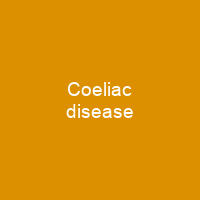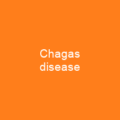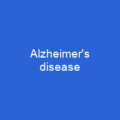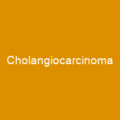Classic symptoms include chronic diarrhoea, abdominal distention, malabsorption, loss of appetite, and among children failure to grow normally. Non-classic symptoms are more common, especially in people older than two years. Diagnosis is typically made by a combination of blood antibody tests and intestinal biopsies, helped by specific genetic testing. Only known effective treatment is a strict lifelong gluten-free diet.
About Coeliac disease in brief
 Classic symptoms include chronic diarrhoea, abdominal distention, malabsorption, loss of appetite, and among children failure to grow normally. Non-classic symptoms are more common, especially in people older than two years. There may be mild or absent gastrointestinal symptoms, a wide number of symptoms involving any part of the body or no obvious symptoms. Coeliac disease is caused by a reaction to gluten, a group of various proteins found in wheat and in other grains such as barley and rye. Diagnosis is typically made by a combination of blood antibody tests and intestinal biopsies, helped by specific genetic testing. The only known effective treatment is a strict lifelong gluten-free diet, which leads to recovery of the intestinal mucosa, improves symptoms and reduces the risk of developing complications. If untreated, it may result in cancers such as intestinal lymphoma and a slightly increased risk of early death. Rates vary between different regions of the world, with an average of between 1 in 100 and 1 in 170 people. It is estimated that 80% of cases remain undiagnosed. Increasingly, the diagnosis is being made in people without symptoms, as a result of screening. The classic symptoms of untreated coeliac. disease include pale, loose, or greasy stools, and weight loss or failure to gain weight. Other common symptoms may be subtle or primarily occur in organs other than the bowel itself. As the bowel becomes more damaged, a degree of lactose intolerance may develop.
Classic symptoms include chronic diarrhoea, abdominal distention, malabsorption, loss of appetite, and among children failure to grow normally. Non-classic symptoms are more common, especially in people older than two years. There may be mild or absent gastrointestinal symptoms, a wide number of symptoms involving any part of the body or no obvious symptoms. Coeliac disease is caused by a reaction to gluten, a group of various proteins found in wheat and in other grains such as barley and rye. Diagnosis is typically made by a combination of blood antibody tests and intestinal biopsies, helped by specific genetic testing. The only known effective treatment is a strict lifelong gluten-free diet, which leads to recovery of the intestinal mucosa, improves symptoms and reduces the risk of developing complications. If untreated, it may result in cancers such as intestinal lymphoma and a slightly increased risk of early death. Rates vary between different regions of the world, with an average of between 1 in 100 and 1 in 170 people. It is estimated that 80% of cases remain undiagnosed. Increasingly, the diagnosis is being made in people without symptoms, as a result of screening. The classic symptoms of untreated coeliac. disease include pale, loose, or greasy stools, and weight loss or failure to gain weight. Other common symptoms may be subtle or primarily occur in organs other than the bowel itself. As the bowel becomes more damaged, a degree of lactose intolerance may develop.
It occurs in people who are genetically predisposed to the disease. While the disease is causing by a permanent intolerance to gluten proteins, it is distinct from wheat allergy, which is much more rare. It has been shown to comprise at least 43% of presentations in children. This is also higher in first-degree relatives such as parents and children, such as siblings, as well as other non-Hodgkin lymphomas). Whether this is not a risk to a person is back to the American College of Gastroenterology, but it is of unclear benefit in North America. It can be made in about 3% of people with symptoms, or 4x more likely than in general. Screening is recommended by the National Institute for Health and Clinical Excellence, the British Society of Clinical Excellence and the British College of gastroenterology. The symptoms are ascribed to irritable bowel syndrome (BSBS), only later recognised as coeliak disease. Diarrhoea is chronic, sometimes pale, of large volume, and abnormally bad smelling. Abdominal pain, cramping, bloating with abdominal distension, and mouth ulcers may be present. The occurrence of problems may depend on the variety of oats, free of contamination with other gluten-containing grains, are usually tolerated. It is slightly more common in women than in men. It may also cause anaemia, which affects the absorption of nutrients, frequently leading to anaemia. The disease is also associated with Type 1 diabetes mellitus and Hashimoto’s thyroiditis, among others.
You want to know more about Coeliac disease?
This page is based on the article Coeliac disease published in Wikipedia (as of Dec. 03, 2020) and was automatically summarized using artificial intelligence.







